
Without bees, there would not be any flowers
I Guess Those Belong There?
When we first moved into our house about fifteen years ago, the previous owners had two nest boxes set up, facing east, on poles on opposite sides of a big detention basin behind the home. My husband and I noticed them, but didn’t think much of them at the time. We thought, “Well, they are there, so I guess those belong there…?” The same was true for the butterfly bush that was at the side steps and the bleeding heart flower by the front steps. Pretty-looking, right?
Now today, our house is home to numerous nest boxes scattered about our property. We slowly saw the benefit those nest boxes provided some fifteen years ago, and now we can’t imagine our home without them. Including a kestrel box that has yet to be occupied (and may never be occupied by a kestrel but we are hopeful), we have nine wooden nest boxes around our home plus a small pottery bird abode that I got at a thrift store. We also recently added a mason bee hotel, or bee abode, as some people like to call them. However, there is not a butterfly bush to be seen, because we later found out they are invasive. While they may look pretty, their ecological benefit is very low. They are not even native to the northeastern United States were we live (and neither is the bleeding heart flower by the way).
One of the greatest benefits to us while being in lockdown is having so many things to watch grow, change, and literally come to life in our yard. We have a fledgling chickadee in one box, (it is really the most darling baby bird I have ever seen*), a few pairs of blue birds rearing their young, and a pair of tree swallows that we see still gathering bits and bobs of leftover dried grasses and such still building their nest as of the second week in May. (As per last year, they don’t fledge until around mid/late June.) Then, we have been watching a mother robin pick up what seems like an endless amount of caterpillars/grubs to rear her three babies in a nest that is just above eye level nestled in a white pine tree that is only about twenty feet tall. She sees us so often, she doesn’t even seem to mind us living on her turf. The blue jay seems to cause her more angst than us. Then we saw the last fledgling leave the nest. It was nearly a bittersweet moment!

So many meals!
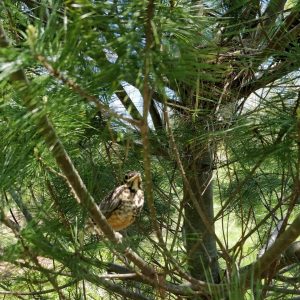
Fledgling robin
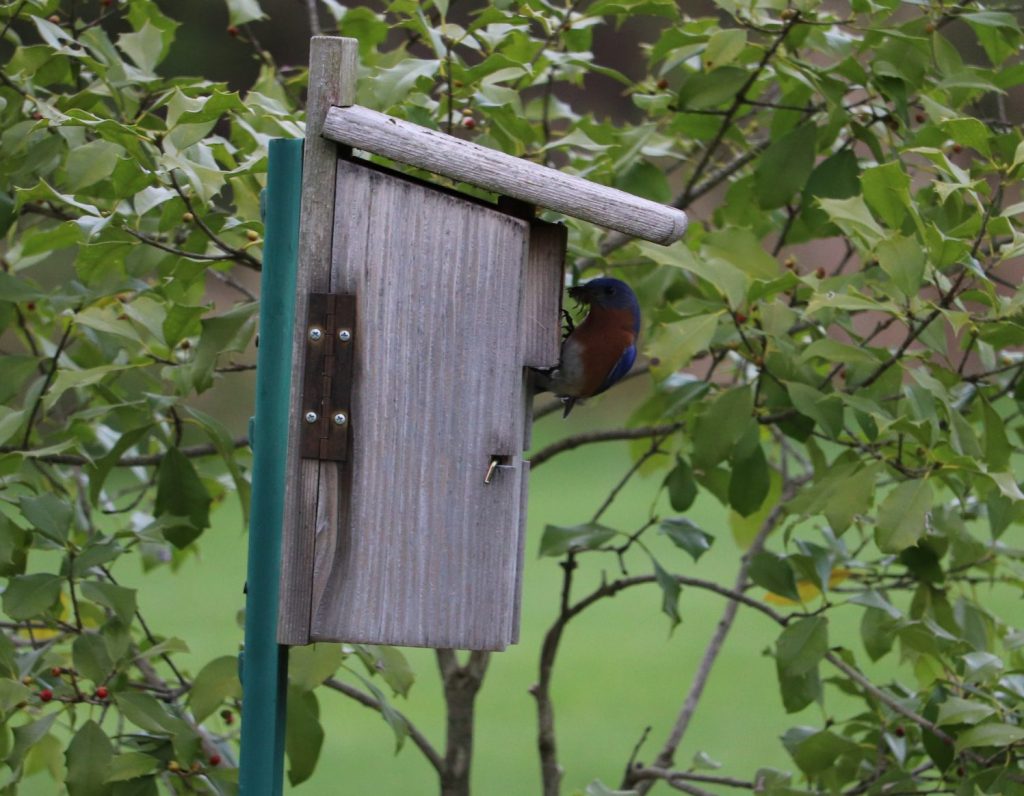
Eastern bluebird
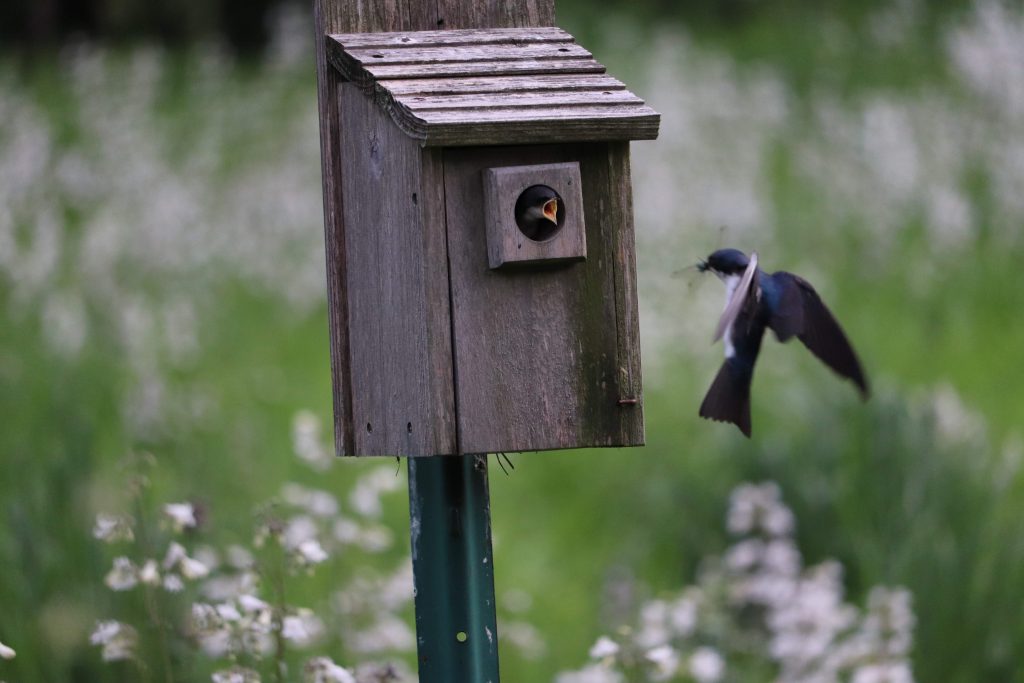
Tree swallow feeding her young (photo taken in 2019)
Our Land is Their Land…And it’s My Own Little #HomegrownNationalPark
The birds, bees, animals, butterflies, and every living thing from the smallest hummingbird or salamander to the greatest bald eagle or great blue heron were here first. So we are on their land. Hence, why my husband and I began converting small patches of our property here and there over the years to native habitats. If you Google “#HomegrownNationalPark” you will see that it is quickly gaining momentum as a thing. We also added a rain garden (to help combat stormwater runoff in the front of our property), a few pollinator islands, and 2 meadows. One large, and one we affectionately call the mini-meadow. I could spend hours in the rain garden. My daughter had a toy boat in there once, and loves splashing in it whenever it is full from a heavy rainstorm. The area around the rain garden is an evolution of it’s own … it changes every day I swear! New buds appear, while the spring plants are in full bloom…meanwhile, the New England asters soon to be necessary food for late migrating monarch butterflies are just getting started. Those asters will reveal their full-on show by mid-August and linger until the somber autumnal sun of late September. Meanwhile, the swamp milkweed will soon be in bloom!

New England asters are a necessary food source for late-migrating monarchs (Photo from 2019)
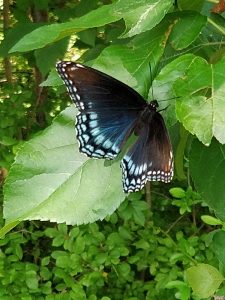
Red Spotted Purple Butterfly, dorsal side

Red Spotted Purple Butterfly, ventral side

Bald Eagle
We Share Our Land
A few years ago we transformed that detention basin that I mentioned above (where the prior owners had placed a nest box) into a wildflower meadow. You can read all about that story here. That evolution began a series of trickle-down effects in our just over 2-acre slice of land. Little by little, we took out what didn’t belong, and added a slew of native plants, shrubs, trees, etc over a period of several years. We have pet names for all the areas of our front, back, and side yards: the Rainbow Garden, the Butterfly Garden, the Rain Garden, and now, aptly named, Robin’s Garden. All because for the countless times we looked out our windows, we saw something. We knew we needed a name for all of this, because too much was happening, and every day was something new. “Look, over there! In the Butterfly Garden, there’s a Baltimore Oriole!” A new bird, a fox playing, a turtle that seemed to had lost its way, a monarch that was truly impossible to catch with a camera, and so, Flutter By Meadows was formed. We knew it needed a name…and finally something hit us on the head. Something is always around, or “flying through” or “fluttering around” and so…not long after our second meadow was formed, the name came to be. We live at Flutter By Meadows, but they were here first. We live in their National Park.

Tiger Swallowtail at Flutter By Meadows

Fox hunting
We Are Never Alone…
Everyone has stories to tell about being in lockdown. About the lines at the store. About the craziness of this unprecedented time. And I often wonder, if and when we return to a normal day-to-day life, or for what it’s worth, maybe a new normal…what will we remember? I know that as a family we are even more aware than we were before about food waste. (Ask my daughter about the sweet potato/beet smoothie I made, so I didn’t waste the dinner from the night before). I can’t say exactly what the future will hold, but I can say that I will remember that this was a time I never felt completely alone. Yes, I miss my friends, and yes, it seems totally awkward to be so far away from our neighbors when we talk, but I can say I will remember never feeling alone. Every time I go outside, whether it is to get the mail, or to just go for a walk up and down the street, I know that I always see something. Our yard is a shared space to come home to, and it’s because of all the native plants dotted around the property. And I am not sure if it’s a product of being home all the time or not, but we have been seeing more birds than we have in any other year. Thank heavens for that too, because bird populations have declined by almost a third in the past half-century, according to a 2019 study. We have so much to be thankful for. Our plants are practically singing in the spring sunlight, and the birds are singing right back. We even had a nest of bunnies that we accidentally unearthed right around the middle of April. A baby bunny is quite possibly the cutest thing ever. Even when my daughter found a snake in the Rainbow Garden, and a salamander in Robin’s Garden it was something to smile about. The ruby-throated hummingbird even returned a little early this year, we saw one on May 1st!
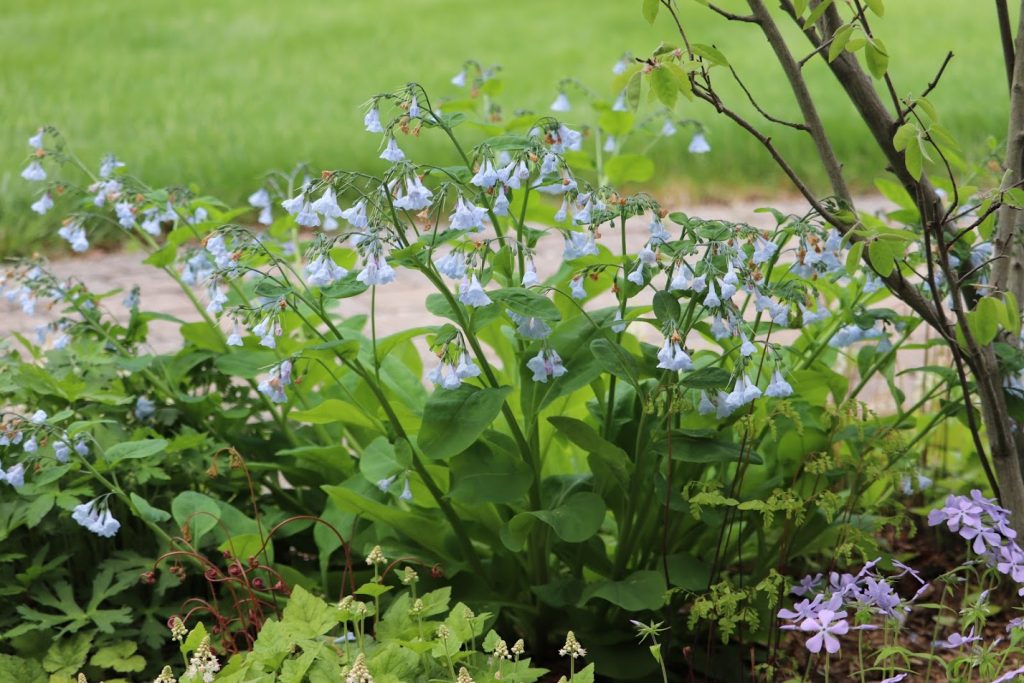
If Virginia Bluebells could sing…these would
Go Out There and Play!
With COVID-19, another wonderful benefit of being at home so much with a school-aged child is that screen time can be more often replaced with “green time”. A fun term I learned from her Forest School teacher where she went to school every day OUTSIDE in pre-school and pre-K. And that is one thing for sure that is a benefit to us all. So many people have learned to ignore the outdoors, even loathe it for its mosquitos, ticks, and other bothersome pests. We used to have a huge problem with Japanese beetles when we first moved to this house. They would annihilate our trees and make eating outside uncomfortable. But as we began to rip out the invasive plants, and add in natives and habitats for birds, the bird population increased. Well, now we don’t have a Japanese beetle problem anymore. Certain birds that migrate here in the spring and summer from the tropics call our land home, like the kingbird and the tree swallow for example. The kingbird, the catbird, as well as woodpeckers and purple martins eat beetles. It’s a beneficial situation and our home is theirs.
My daughter has spent countless hours watching Mrs. Robin these past few weeks. She would practically run outside at the drop of hat if I said, “Shall we go check on Mama Robin?” So if for nothing else that I remember about this quarantine situation, I know I’ll remember spending hours outside, just enjoying the small slice of land that I share with all the creatures around us. And how thankful we are to be able to help the pollinators and help the birds find a tiny piece of land that supplies what they need. They certainly don’t need lawn and grass…what they need are native plants. They need trees and shrubs. And they need our help.
Native Plants Are Getting a Bad Rap
But some native plants have well, not the prettiest of names. Golden ragwort, swamp azalea. Hmm…not exactly “blooming beauty” or “glammin’ gorgeous”. We have plenty of native plants which, when you see their names on paper, you might actually say to yourself: “but it’s a weed, why would I want that?” But…if you look up “Joe Pye Weed”, “New York ironweed”, “milkweed”, “sneezeweed” or “swamp milkweed” you will be surprised. They are not ugly, nor unwanted. They are completely NECESSARY! But we do NOT have any butterfly bushes. They do more harm than good. And you know what, I never have to use a hose to water my plants. They are used to heat waves or cold spells (remember the frosts of early May?) Native plants and grasses roots go deep, over the millenia, they did this funny thing called adapt. I don’t need to stand out there with a hose watering plants and lawn with short root systems; I stand in my yard with a camera. Just hoping for that next great bird picture! I do wonder what my neighbor’s think of me…standing for 30 minutes looking up at a tree with my Canon camera around my neck.
Somewhere along the line, America got the wrong idea. Lawn is nothing more that something that needs to be methodically mowed in perfect straight lines. Have you ever even seen a butterfly land on a blade of grass? I haven’t. There’s even a new mow-vement going on… what, you haven’t heard? People are actually going to avoid cutting the grass for 30 days. It’s called “No Mow May.” Oh my goodness, what?? No more perfectly straight, criss-crossed lines??? Ahhh!!!!! That’s nuts! Or is it? Leaving our lawns long and unmanicured? Oh my word, the horror. I encourage it wholeheartedly!
One thing that our front and back and side yards are really good at…is providing endless hours of enjoyment, not only for us, but for the birds, pollinators and everything that uses our little #HomegrownNationalPark as a home. A place to be in nature, and enjoy every lasting minute of it. Not only that, our little slice of gardening heaven also gives back. We have pollinator “islands” scattered about and we have a rain garden to help with stormwater runoff. Yet none of this would be possible if our front and backyard was 90% lawn.
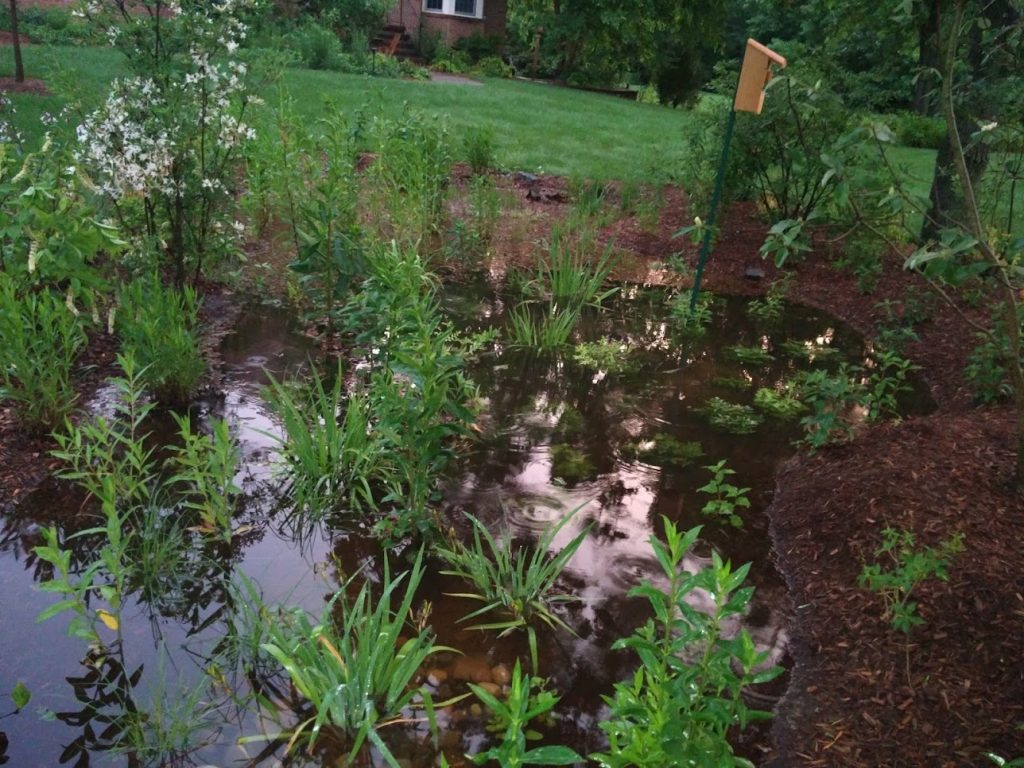
Full Rain Garden
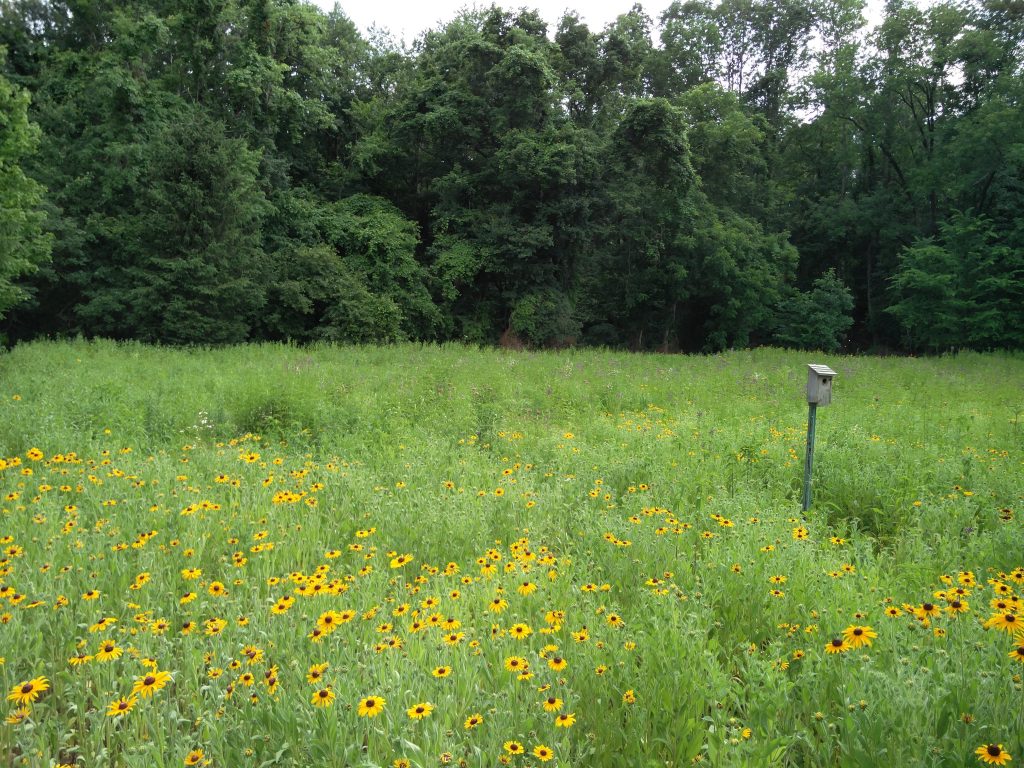
Meadow in Bloom

Mini Meadow in Bloom
Weeds Are Not Always in the Wrong Place
A weed is a plant considered undesirable in a particular situation, “a plant in the wrong place”…According to Wikipedia. The native plants that I mentioned above are so named because they kept creeping up naturally when the early settlers of America came to the East coast and started planting crops, they had always been there even before human settlement. They were named “weeds” because they were native and belonged there, yet were in the way of the crops. But were they in the wrong place? Well, times have changed, and we really need them back. I recently learned this from reading Doug Tallamy’s latest book, which was a wonderful read. I highly recommend.
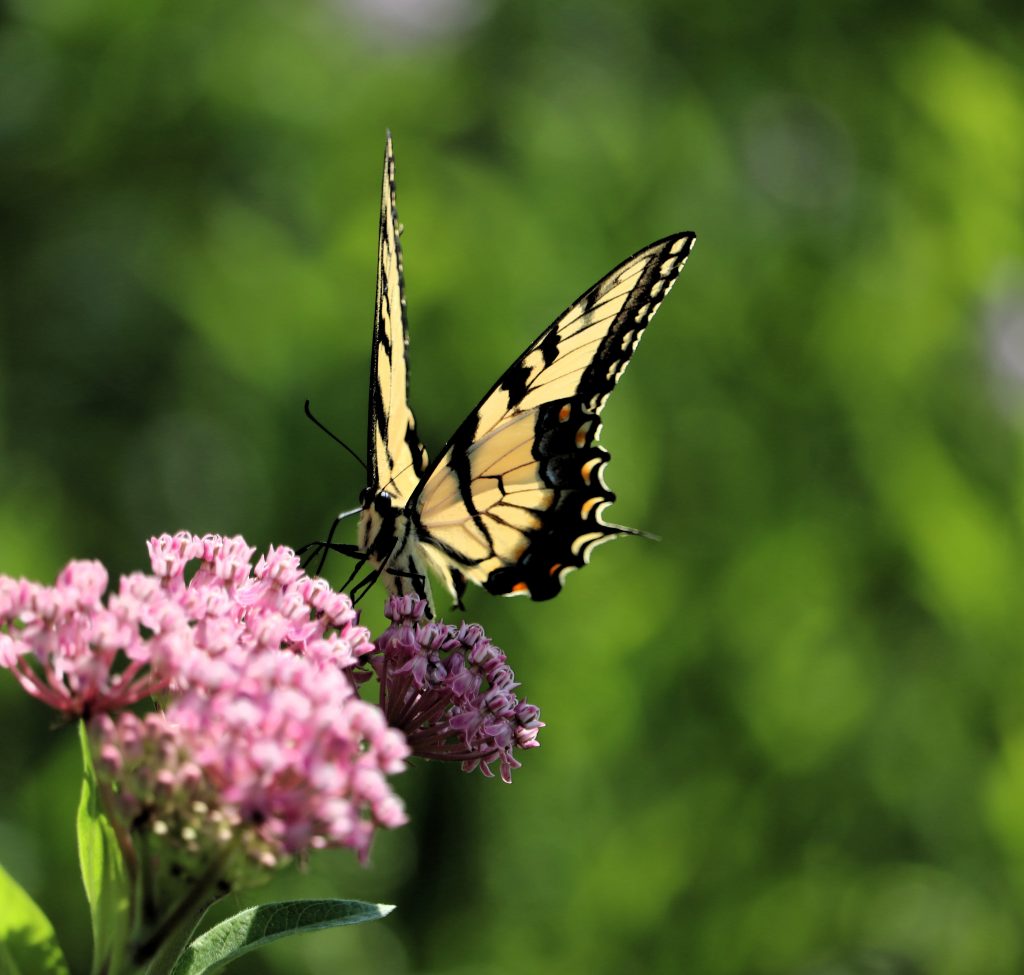
Tiger Swallowtail on Swamp Milkweed
Nature’s Best Hope: A New Approach to Conservation That Starts in Your Yard, by Doug Tallamy
This book I think tells a wonderful story, and in my mind, why my yard is well on the way to helping out the cause of being Nature’s Best Hope. The Earth is not going to save itself. And little by little, we need to be mindful of what we plant and where. If it’s not native, it really doesn’t belong in our yards, and if it’s a weed, well…it probably does. And by all means possible, shrink the lawn wherever you can!
And if my daughter is seeing the benefits early on of conservation and sharing the planet then maybe there is hope, and she is indeed growing up “green”. We just need to plant even more native plants. Nothing ornamental, nothing from another land. Nothing from across the sea. Plant what works where you live, and give back to nature, so that our lands are a shared space with those that were here first. So that in years to come, there’s even a nature to come home to at all. We will eventually leave quarantine, and resume the new normal…we just need to make sure that the birds and especially the pollinators also have something to come home to too, because they have been trying to come home all along.
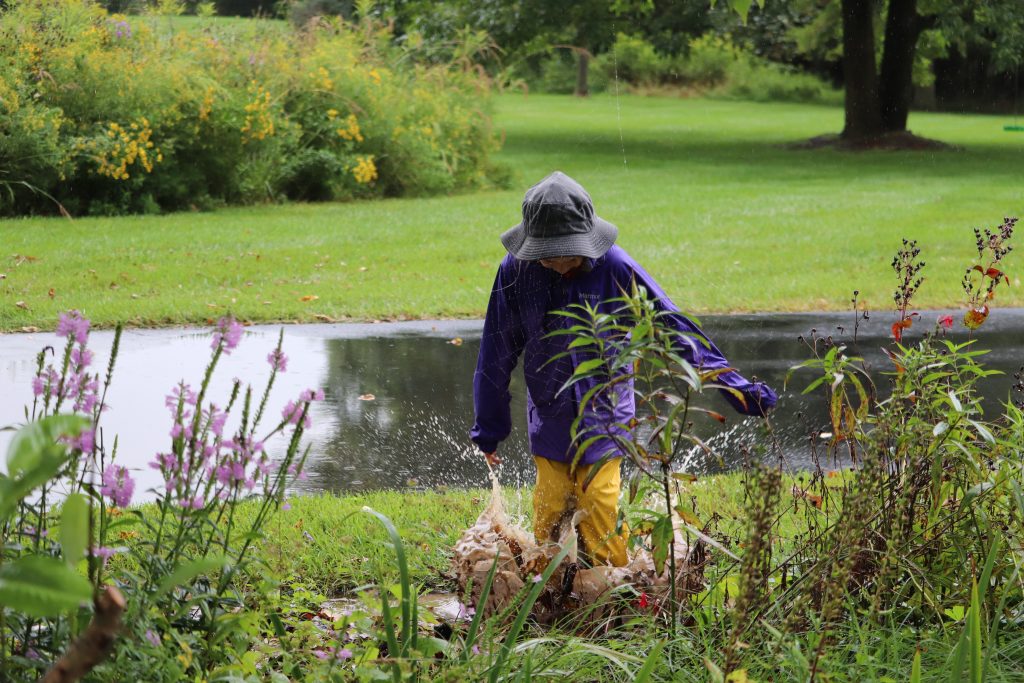
Splashing in the rain garden, mini meadow is in the background
*To view the baby birds / nest building on our property we use a special endoscopic camera that is very small and fits through the small opening of the nest box which is then connected remotely through our mobile phone. We do so carefully, and without disturbing the mama or the babies.

2 Responses
I love this blog. Living in the city, I do not get to see so many beautiful creatures! And I agree, “we share this land!” What an inspiring, beautiful blog.
Fantastic and inspiring. I’m just at the beginning of the journey you’ve been on… removing the non-natives and planting more natives… and I share your view that the land I’m on is more theirs than mine. I’m thrilled to see what shows up in the future (already have quite a few robins, catbirds, song sparrows nesting in my shrubs). Also, I’m intrigued by the idea of a rain garden. I have an area of my yard that turns into a giant puddle during heavy rains… now I know what to do with it!